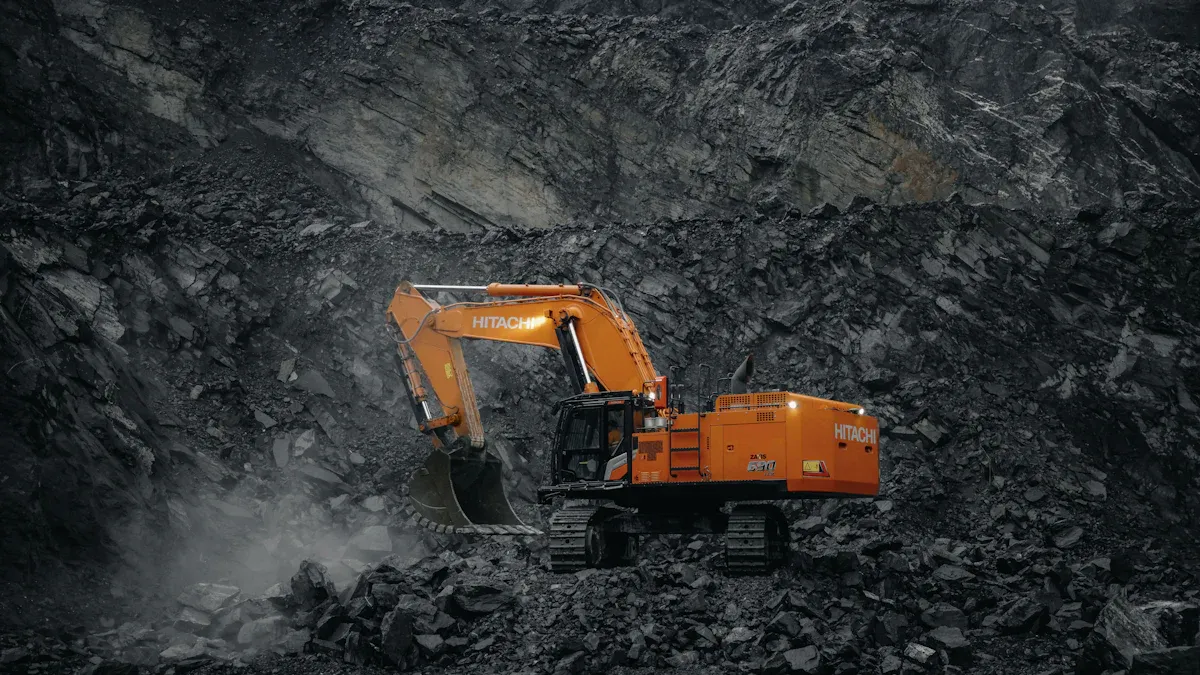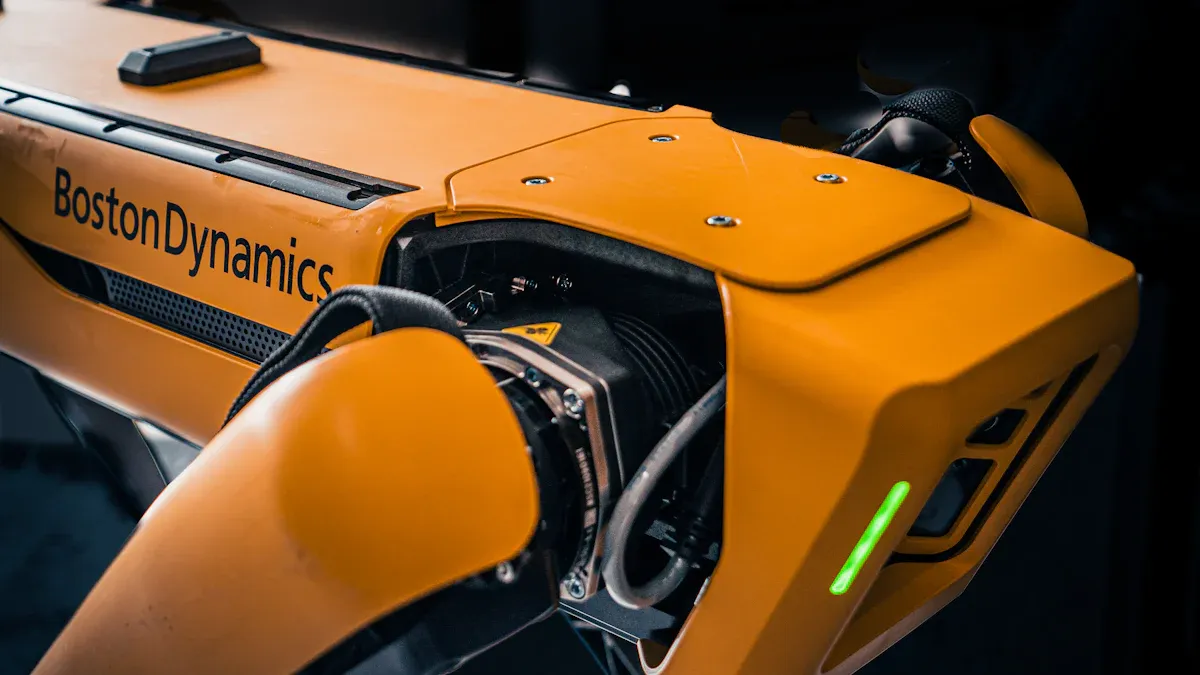How Predictive Maintenance for AI Store Machines Supports Sustainable Operations

Predictive maintenance helps AI store machines work better. It makes less waste and uses less energy. Machines break down less often. Many stores see big changes. For example, Target’s AI program saved lots of money. It saved over $50 million every year. It did this by stopping spoilage and improving waste collection. Finding problems early keeps machines working well. It also helps use less energy. You help make stores more green with these smart systems.
Key Findings | Details |
|---|---|
Cost Reduction | Target's AI-powered waste program saved over $50 million yearly |
Waste Management Improvements | Reduced spoilage and better collection schedules |
Key Takeaways
Predictive maintenance helps stores save money. It stops machines from breaking down often. This also lowers the cost to fix machines. Stores like Target save more than $50 million each year.
Sensors give real-time data to spot problems early. This means there are fewer repairs and less waste. Machines work better and last longer.
Predictive maintenance can make machines last up to 40% longer. This means you do not need to buy new machines as often. It also lowers the total cost for the store.
Predictive maintenance helps the planet by using less energy. It also makes less waste. Machines that work well are better for the environment.
It is important to train your team on these tools. When workers know how to use them, they work better. This helps your store get the most benefits.
Predictive Maintenance Overview
What Is Predictive Maintenance
Predictive maintenance uses data and smart tools to keep machines working. It checks equipment all the time with real-time information. This helps find problems before machines stop working. You do not wait for a breakdown to happen. Instead, you use the data to plan when to fix things. This way, you save money and your store keeps running well.
You can look at the table below to see how predictive maintenance is different from traditional maintenance:
Aspect | Predictive Maintenance | Preventive Maintenance |
|---|---|---|
Approach | Driven by real-time machine conditions | Based on predetermined intervals |
Maintenance Timing | Interventions based on actual equipment condition | Scheduled at regular intervals regardless of condition |
Efficiency | Reduces unnecessary maintenance and costs | May lead to under- or over-maintenance |
Traditional maintenance means you fix things after they break or by a set schedule. Predictive maintenance uses real-time data to guess when equipment might fail. This helps you skip repairs you do not need and saves money.
How It Works in AI Store Machines
AI store machines have sensors and smart programs to watch equipment. These sensors check things like temperature, vibration, and pressure. If something changes, the system sees it right away. AI and machine learning look at the data. They find patterns and warn you if a part could break soon.
Here is how sensor-driven predictive maintenance works in your store:
Sensors gather data about machine health, like vibration, temperature, and humidity.
AI systems study this data to spot small changes that could mean a problem.
The system sends alerts if it finds an issue, so you can fix it early.
You only do maintenance when it is needed, not just because it is time.
With ai store machines, you get fewer breakdowns and use less energy. Your equipment lasts longer too. This helps your store work better and be more green.
Sustainability Benefits

Energy and Resource Savings
Predictive maintenance helps stores save energy and resources. These systems watch machines all the time and find problems early. When machines work well, they use less power and fewer parts. This means you do not waste energy or change parts too soon.
Here is a table that shows how much you can improve with predictive maintenance:
Benefit | Percentage Improvement |
|---|---|
Equipment availability | 5-15% |
Maintenance costs reduction | 18-25% |
Preventive maintenance spend cut | Up to 50% |
You also make less waste because you only fix what is needed. This is good for the environment and saves money. When machines run better, you use less electricity and fewer materials. Your store becomes more efficient and eco-friendly.
Less Downtime, Less Waste
If a machine breaks, your store loses time and money. Predictive maintenance helps stop this from happening. The system warns you before a machine fails, so you can fix it fast. This keeps your store open and stops waste from spoiled food or broken equipment.
Cristee Monahan, VP of Central Operations at City Facilities Management, says, "Equipment downtime, especially for refrigeration systems, directly translates to lost sales and profits. It can also negatively impact customer loyalty and brand reputation, particularly if temperature standards are compromised."
You can see the benefits in these numbers:
Benefit | Percentage Reduction |
|---|---|
Overall maintenance costs | 20-25% |
Downtime | 35-45% |
With less downtime, you throw away less food and use fewer resources. You also avoid extra costs from emergency repairs. Your team can help customers instead of fixing machines. This makes your store more reliable and protects your brand.
Longer Equipment Life
Predictive maintenance helps machines last longer. The system finds small problems early, so you can fix them before they get worse. This keeps your equipment working well for more years.
AI predictive maintenance can make equipment last about 40% longer.
Finding problems early means less damage.
Machines use 12-18% less energy when they work well.
When machines last longer, you do not need to buy new ones as often. This saves money and makes less waste. You also avoid big repair bills and lost sales from broken equipment.
Impact on Cost Savings | |
|---|---|
Extended equipment lifespan through predictive maintenance | Maximizes return on asset investments and reduces overall maintenance costs |
Prevents unplanned downtime and catastrophic failures | Avoids costs associated with manufacturing downtime, which can reach $150,000 per hour |
Uses real-time data for optimal maintenance timing | Leads to longer equipment lifespans and improved reliability, reducing emergency repair costs |
You get more value from every machine in your store. You also help the planet by using fewer resources and making less waste. Predictive maintenance is a smart way to keep your store running well and sustainably.
Technologies Behind Predictive Maintenance

AI and Machine Learning
AI and machine learning can help your store work better. These tools find problems before they get worse. Machine learning looks at lots of data from your machines. It learns what is normal and spots changes fast. The more it learns, the better it gets at guessing when something might break.
Here is how machine learning helps with maintenance:
Aspect | Description |
|---|---|
Adaptability | Algorithms get smarter and make better guesses. |
Data Analysis | They look at lots of data to help you decide. |
Predictive Maintenance | They find problems early to stop breakdowns. |
You do not have to fix things on a set schedule. You use real-time data to know when to repair. This stops surprise problems and keeps your store open.
Sensors and Real-Time Data
Sensors are important for predictive maintenance. You put sensors on machines to watch things like heat, shaking, and pressure. These sensors check your machines all the time. If something is wrong, the sensors notice right away.
Sensors show you how your machines are doing right now.
AI uses this data to know when a machine needs help.
You can fix things early and save money and time.
Companies like PETRONAS and Duke Energy use sensors and AI to save money and stop downtime. You can use these tools to make your store run better.
Analytics for Store Machines
Analytics help you understand your machine data. You use analytics to see what your machines are telling you. There are different kinds of analytics that help in many ways:
Type of Analytics | Description |
|---|---|
Data Collection | Sensors gather facts about your machines. |
Model Development | Machine learning makes models to guess problems. |
Anomaly Detection | Systems find strange patterns that could mean trouble. |
Failure Prediction | Analytics guess when a machine might break. |
Maintenance Scheduling | You plan repairs at the best time, not too soon or late. |
Continuous Improvement | Models get better as they learn from new data and fixes. |
Advanced analytics help you make smart choices for your store. For example, CORTIX™ let stores fix things from far away, so fewer technicians had to visit. One store chain saved 26% on energy costs in 1,500 stores. You can use analytics to save energy, waste less, and keep your store working longer.
Tip: Using predictive maintenance with AI, sensors, and analytics makes your store stronger and more green.
Implementing Predictive Maintenance
Assessing Store Machines
You begin by checking your store’s machines. Decide which ones need predictive maintenance. First, think about what predictive maintenance means for your store. Then, set goals that are easy to understand. Connect your data sources and use smart software. Set up alerts so you can find problems early.
When picking machines to upgrade, ask yourself some questions. What does your store need? What kinds of machines do you have? Can your old systems work with new ones? What is your plan for fixing things now? Do you have enough IT help? What is your budget and future plan? Can you make the system bigger later?
You should also see if the solution fits your store and machines. Make sure it works well with your systems. It should be simple for your team to use.
Setting Up Data and Monitoring
Good data is very important for predictive maintenance. Start by finding the best places to get data, like old repair records and sensor data. Make sure your data is correct and clean. Use IoT sensors to watch machines in real time. This helps you find problems early and plan repairs automatically.
Description | |
|---|---|
Identify Data Sources | Use both old records and live sensor data. |
Ensure Data Quality | Audit and standardize data entry often. |
Utilize IoT | Add sensors for real-time checks and early warnings. |
Automatic repair planning uses this data to pick the best time for fixes. Clean data helps the system guess problems better and gives you good advice.
Training and Protocols
Your team needs to learn how to use predictive maintenance tools. Teach them how the technology works. Show them how to use sensors and other tools. Help them learn to read and understand the data. Technicians and IT workers may need extra lessons. Managers should make sure everyone follows the right steps and keeps data clean.
Description | |
|---|---|
Understanding Technology | Learn how predictive maintenance works. |
Using Monitoring Equipment | Practice with sensors and tools. |
Data Interpretation | Know how to read and act on the data. |
Work with vendors or schools for hands-on classes and certificates.
Measuring Sustainability
Check your progress to see how predictive maintenance helps your store. Use real-time energy checks to see how much power your machines use. Look for patterns to find ways to save more energy. Check how much waste you save by only changing parts when needed. Automatic repair planning helps you avoid buying too many parts and wasting them.
Real-time checks show energy use and help you make fast choices.
You can see money saved from better machine use and less waste.
Predictive maintenance makes machines last longer and break down less.
By checking these results, you make your store work better and greener. You also show why moving to smart, data-driven care is a good idea.
Predictive maintenance lets your store be more eco-friendly. You throw away less and save energy. Your machines last longer too.
You find and fix small problems early. This means you do not waste as much and need fewer repairs.
You use less power because your equipment works well.
You help the earth by having fewer repair trips and stopping leaks.
AI will keep making stores smarter. You will get better guesses for what to sell. You will have the right amount of products and not too much extra. Using these tools helps your store and also helps the planet.
FAQ
What is predictive maintenance for AI store machines?
Predictive maintenance helps your store machines work well. You watch your machines closely with this method. You can find small problems before they get worse. This lets you fix things early. Your machines last longer and work better.
How does predictive maintenance help with sustainability?
Predictive maintenance makes your machines use less energy. You also make less waste. Your machines stay in good shape for a long time. You do not have to replace them often. This helps your store care for the environment.
Can predictive maintenance save money on store assets?
Yes, predictive maintenance helps you save money. You do not have to pay for big repairs as often. Your machines work longer, so you buy new ones less. You also spend less on emergency fixes.
What types of assets benefit most from predictive maintenance?
Assets like refrigerators, HVAC systems, and checkout machines benefit most. These machines run every day in your store. Predictive maintenance keeps them working well. You can avoid sudden breakdowns.
How do you start predictive maintenance for your store assets?
First, check your machines and add sensors to them. Collect data from your machines and use AI tools to watch for problems. Train your team to use the system. This keeps your machines healthy and your store running well.
See Also
The Future of Retail: Embracing AI-Driven Stores
Modern Retail Benefits from AI-Enhanced Combo Vending Machines
Transforming Online Retail Management with AI E-Commerce Tools
Understanding the Growth of AI-Driven Corner Stores
Key Maintenance Advice for Vending Machine Security Features
